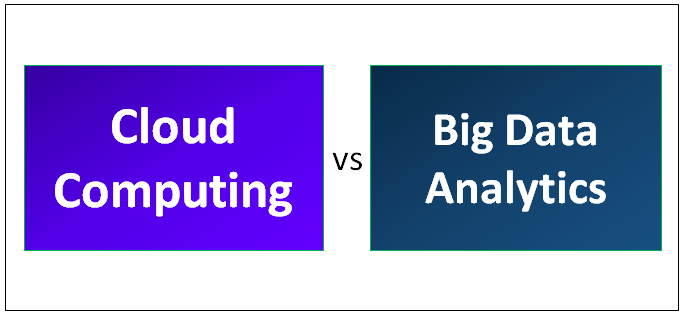
The terms Big Data and Cloud Computing have been bandied around a lot. Have we ever heard about the distinction between these two terms? So let’s have a look at the differences between Big Data and Cloud Computing in today’s essay.
Table of Contents
What is Big Data, exactly?
Big Data is mostly used to describe data that is vast in size and grows fast over time. Big Data is made up of both structured and unstructured data, as well as semi-structured data.
Organizations are unable to process Big Data using typical data processing methods and management technologies. Big data processing necessitates the use of specialized big data management software. It has vast and complicated sets that include the following:
Volume
Velocity
Veracity
Value
Variety
Variety
Structured, semi-structured, and unstructured data make up Big Data.
Velocity
The pace with which data is generated is what Big Data is all about.
Volume
Big Data generates a large amount of data.
Value
Users can acquire relevant information and make it worthwhile with Big Data.
Variability
The inconsistency that the information may display at times.
It’s also known as the 5Vs Information Assets model. Data storage, data analysis, data mining, and data visualization are among them. The most popular source or platform for big data generation is social media, followed by weather stations, IoT devices, e-commerce data, and many more.
Big Data’s Advantages
The following are some of the advantages of big data:
Cost-cutting
More Decision-Making
Improved Sales Insights
Productivity has improved.
Customer Service Improvements
Big Data’s Drawbacks
The following are some of Big Data’s drawbacks:
Incompatible tools
Concerns about security and privacy
The necessity of cultural transformations
Technology evolves at a breakneck pace.
Requirements for Specific Hardware
What is Cloud Computing, and how does it work?
Cloud computing is defined as a set of on-demand computing services accessible over the internet. The following are some of the resources:
Servers
Storage
Databases
Software
Analytics
Networking
Users of Cloud Computing must pay based on the number of services used. Cloud computing is extremely adaptable, and it can be swiftly scaled up or down depending on the application. Users can choose from three service models provided by Cloud Computing:
Infrastructure-as-a-Service (IaaS)
Platform-as-a-Service (PaaS)
Software-as-a-Service (SaaS)
Cloud Computing Providers
The following are some of the most well-known cloud computing vendors in the world:
Amazon Web Services (AWS)
Microsoft Azure
Google Cloud Platform
IBM Cloud Services
Cloud Computing’s Advantages
The following are some of the advantages of cloud computing:
Data can be backed up and restored regularly.
It has enhanced teamwork.
Cloud Computing has a low-cost maintenance model.
It provides Self-Service on Demand.
Cloud Computing’s Disadvantages
The following are some of the disadvantages of cloud computing:
The user has a limited amount of control.
Users are concerned about their safety.
Downtime can occur for a variety of reasons.
It necessitates a steady internet connection.
Cloud computing uses the internet to provide an on-demand set of computing resources.
Cloud Computing vs Big Data
| Big Data | Cloud Computing |
| Big Data refers to large amounts of data that are growing in size over time. | Cloud computing uses the internet to provide an on-demand set of computing resources. |
| Structured Data, Unstructured Data, and Semi-Structured Data are the three types of Big Data. | Users using cloud computing will have access to services such as IaaS, PaaS, and SaaS. |
| Volume, Velocity, Variety, and Data Value are the most important characteristics of Big Data. | On-Demand Availability of Resources, Wide Range of Network Access, Availability of Resource Pooling, Elasticity, and Measured Service are the most important aspects of Cloud Computing. |
| The primary goal of Big Data is to organize huge amounts of data and extract useful information from them. This data can be used to improve a company’s performance. | The primary purpose of cloud computing is to store and process data. Otherwise, it is used for distant IT services that do not necessitate the installation or maintenance of infrastructure. |
| Distributed computing is utilized in Big Data to do analytics and gather useful information. | Cloud computing makes use of the Internet to obtain cloud services from a variety of cloud vendors. |
| Big Data Management provides a consolidated platform for backup and recovery, as well as low-cost maintenance. | Cloud computing provides cost-effective, scalable, and large-scale services. |
| Various forms of data, data storage, data integration, data processing, and resource management are all concerns in Big Data. | Availability, transformation, security challenges, and pricing or charging model are all issues in cloud computing. |
| The term Big Data relates to large amounts of data, their administration, and the extraction of useful information. | Cloud computing is the process of storing data and information on remote servers and processing that data using the remote infrastructure. |
| Data from social media, e-commerce, IoT sensors, and weather stations are some of the most common sources of Big Data. | Amazon Web Services (AWS), Microsoft Azure, Google Cloud Platform, and IBM Cloud Services are some of the most well-known Cloud Computing providers. |
Summary
As a result, we have attempted to offer you extensive information on the Big Data Vs. Cloud Computing debate in this post. We hope you enjoy our efforts.

